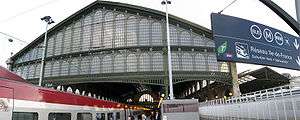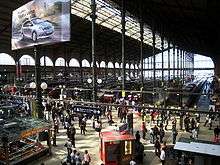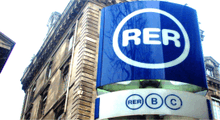Gare du Nord
| Terminus | ||||||||||||||||||||||||||||||||||||||||||||||||||||||||||||||||||||||||||||||||||||||||||||||||||||||||||||||||||||||||||||
 Main hall | ||||||||||||||||||||||||||||||||||||||||||||||||||||||||||||||||||||||||||||||||||||||||||||||||||||||||||||||||||||||||||||
| Location |
112 Rue de Maubeuge 75010 Paris Île-de-France France | |||||||||||||||||||||||||||||||||||||||||||||||||||||||||||||||||||||||||||||||||||||||||||||||||||||||||||||||||||||||||||
| Coordinates | 48°52′51″N 2°21′19″E / 48.8809°N 2.3553°E | |||||||||||||||||||||||||||||||||||||||||||||||||||||||||||||||||||||||||||||||||||||||||||||||||||||||||||||||||||||||||||
| Owned by | SNCF | |||||||||||||||||||||||||||||||||||||||||||||||||||||||||||||||||||||||||||||||||||||||||||||||||||||||||||||||||||||||||||
| Line(s) | Paris–Lille railway | |||||||||||||||||||||||||||||||||||||||||||||||||||||||||||||||||||||||||||||||||||||||||||||||||||||||||||||||||||||||||||
| Platforms | 36 (two not in service) | |||||||||||||||||||||||||||||||||||||||||||||||||||||||||||||||||||||||||||||||||||||||||||||||||||||||||||||||||||||||||||
| History | ||||||||||||||||||||||||||||||||||||||||||||||||||||||||||||||||||||||||||||||||||||||||||||||||||||||||||||||||||||||||||||
| Opened | 1864 | |||||||||||||||||||||||||||||||||||||||||||||||||||||||||||||||||||||||||||||||||||||||||||||||||||||||||||||||||||||||||||
| Rebuilt | 1889 (expanded 1930s-1960s) | |||||||||||||||||||||||||||||||||||||||||||||||||||||||||||||||||||||||||||||||||||||||||||||||||||||||||||||||||||||||||||
| Electrified |
25 kV 50 Hz 1.5 kV DC (Underground RER Lines) | |||||||||||||||||||||||||||||||||||||||||||||||||||||||||||||||||||||||||||||||||||||||||||||||||||||||||||||||||||||||||||
| Traffic | ||||||||||||||||||||||||||||||||||||||||||||||||||||||||||||||||||||||||||||||||||||||||||||||||||||||||||||||||||||||||||||
| Passengers | 190 million | |||||||||||||||||||||||||||||||||||||||||||||||||||||||||||||||||||||||||||||||||||||||||||||||||||||||||||||||||||||||||||
| ||||||||||||||||||||||||||||||||||||||||||||||||||||||||||||||||||||||||||||||||||||||||||||||||||||||||||||||||||||||||||||
.jpg)



Paris Nord (or the Gare du Nord, "North Station", pronounced: [ɡaʁ dy nɔːʁ]) is one of the six large terminus stations of the SNCF mainline network for Paris, France. Located not far from Gare de l'Est in the 10th arrondissement, the Gare du Nord offers connections with several urban transportation lines, including Paris Métro, RER and Buses. By the number of travelers, at around 190 million per year, it is the busiest railway station in Europe[1] and the busiest in the world outside Japan.[2]
The Gare du Nord is the station for trains to Northern France and to international destinations in Belgium, Germany, the Netherlands, and the United Kingdom. The station complex was designed by the French architect Jacques Hittorff[3] and built between 1861 and 1864.
History
The first Gare du Nord was built by Bridge and Roadway Engineers on behalf of the Chemin de Fer du Nord company, which was managed by Léonce Reynaud, professor of architecture at the École Polytechnique. The station was inaugurated on 14 June 1846, the same year as the launch of the Paris–Amiens–Lille rail link. Since the station was found to be too small in size, it was partially demolished in 1860 to provide space for the current station. The original station's façade was removed and transferred to Lille.
The chairman of the Chemin de Fer du Nord railway company, James Mayer de Rothschild, chose the French architect Jacques Ignace Hittorff to design the current station. Construction lasted from May 1861 to December 1865, but the new station opened for service while still under construction in 1864. The façade was designed around a triumphal arch and used many slabs of stone. The building has the usual U-shape of a terminus station. The main support beam is made out of cast iron. The support pillars inside the station were made at Alston & Gourley's ironworks in Glasgow in the United Kingdom, the only country with a foundry large enough for the task.
The sculptural display represents the principal cities served by the company. Eight of the nine most majestic statues, crowning the building along the cornice line, illustrate destinations outside France, with the ninth figure of Paris in the center. Fourteen more modest statues representing northern European cities are lower on the façade. The sculptors represented are:
- London and Vienna by Jean-Louis Jaley
- Brussels and Warsaw by François Jouffroy
- Amsterdam by Charles Gumery
- Frankfurt by Gabriel Thomas
- Berlin by Jean-Joseph Perraud
- Cologne by Mathurin Moreau
- Paris, Boulogne and Compiegne by Pierre-Jules Cavelier
- Arras and Laon by Théodore-Charles Gruyère
- Lille and Beauvais by Charles-François Lebœuf
- Valenciennes and Calais by Philippe Joseph Henri Lemaire
- Rouen and Amiens by Eugène-Louis Lequesne
- Douai and Dunkirk by Gustave Crauck
- Cambrai and Saint-Quentin by Auguste Ottin
It was originally planned that a monumental avenue would be constructed leading up to the station's façade, cutting through the old street layout. However, this was never built due to a dispute between de Rothschild and Baron Georges-Eugène Haussmann during his rebuilding of Paris. One version claims that the lack of a boulevard was due to Haussmann discovering that his wife was having an affair with the Gare du Nord's architect, Jacques Ignace Hittorff, though this story is unlikely, since Hittorff, born in 1792, was seventy-three years old when the station was completed, and died two years later. Whatever the reason, the station has persistently suffered problems with a lack of space and poor access.[4]
To remedy these problems, in 2015 SNCF engaged the architect Jean-Michel Wilmotte to "open the station towards the city". It is intended that the station will undergo a major refurbishment to be completed by 2024, when Paris hopes to host the Olympic Games. The station will remain open during the renovations. The mayor of Paris, Anne Hidalgo, has also pledged to address the traffic problems in front of the station by reconfiguring its approaches.[4]
Service
Like other Parisian railway stations, the Gare du Nord rapidly became too small to deal with the increase in railway traffic. In 1884, engineers were able to add five supplementary tracks. The interior was completely rebuilt in 1889 and an extension was built on the eastern side to serve suburban rail lines. More expansion work was carried out between the 1930s and the 1960s.
Beginning in 1906 and 1908, the station was served by the Metro Line 4, which crosses Paris from north to south, and the terminus of Metro Line 5, which ran to Étoile through Place d'Italie. In 1942, Line 5 was extended towards the northern suburbs of Pantin and Bobigny, while its south terminus was set to Place d'Italie. Metro Line 2 (station La Chapelle) is linked to the Gare du Nord via an underground tunnel. One enters the Métro station and, instead of climbing the stairs that lead to the elevated métro line (not all of Line 2 is elevated) descends several flights of stairs, before traversing a long, arched circular hallway to enter the station.
Finally, in 1994, the arrival of Eurostar trains required another reorganisation of the rail tracks:
- Platforms 1 and 2: Service platforms, not open to the public.
- Platforms 3 to 6: Terminus of the London Eurostar via the Channel Tunnel.
- Platforms 7 and 8: Thalys platforms for Belgium, Germany and the Netherlands.
- Platforms 9 to 18: TGV North, Main Line trains, and some Picard TER.
- Platforms 19 to 21: Picard TER.
- Platforms 30 to 36: Suburban station, Transiliens and Picard TER (Paris-Beauvais line)
- Platforms 41 to 44 (underground): RER station, lines B and D.
- 4 Métro Platforms (underground): Lines 4&5
It is also connected to Magenta RER Station (4 platforms, line E) and La Chapelle Métro Station (2 platforms, line 2).
Today, the Gare du Nord is the busiest railway station in Europe, with over 700,000 passengers daily. Most of the passengers are commuters travelling in from the northern suburbs of Paris and outlying towns; only 3 per cent of the traffic is accounted for by Eurostar.[4]
There is a further construction project to build a connecting hallway between Gare du Nord and Gare de l'Est, which is projected to open around the time when the new LGV Est begins serving the station. When open the Gare du Nord-Gare de l'Est complex (including Magenta & La Chapelle) will have 77 platforms.
Security for the station is provided by the French police, the railways police and private security companies. Due to the position of the station as a gateway to the northern suburbs of Paris, there are some parts of the station where security incidents occur from time to time.[5]
In popular culture
The Gare du Nord has served as a backdrop in numerous French films, for instance in Les Poupées Russes.
In Nancy Mitford's The_Pursuit_of_Love Linda first meets Fabrice in the Gare du Nord when she's run out of resources and is sitting weeping on her suitcase.
In US movies, both the exterior and the interior of the Gare du Nord are seen in the 2002 film The Bourne Identity with Matt Damon and again in the trilogy's finale, The Bourne Ultimatum, released in August 2007. It was also seen in Ocean's Twelve in 2004,[6] and Mr Bean's Holiday in 2007. The ending of the 2012 movie The Raven by James McTeigue takes place at the station.
Scenes of Gossip Girl's episode "Double Identity" were shot inside the Gare du Nord.[7]
It is also mentioned in "Polaris" by Jimmy Eat World off their album Futures. In addition, the station was featured in the video for the song "Home" by Blake Shelton. One of Poésie Noire songs is called "Gare du Nord". Furthermore, Keaton Henson has a song titled '10am Gare du Nord'.
The station is also mentioned in The Da Vinci Code by Dan Brown, as well as in The Historian by Elizabeth Kostova.
Train services
The following services currently call at Paris Nord:
- High speed services (Eurostar) Paris - London
- High speed services (Thalys) Paris - Brussels - Amsterdam
- High speed services (Thalys) Paris - Brussels - Cologne - Essen
- High speed services (Thalys) Paris - Brussels - Cologne
- High speed services (TGV) Paris - Lille
- High speed services (TGV) Paris - Lille - Tourcoing
- High speed services (TGV) Paris - Lille - Calais
- High speed services (TGV) Paris - Lille - Calais - Boulogne - Rang-du-Fliers
- High speed services (TGV) Paris - Lille - Dunkerque
- High speed services (TGV) Paris - Arras - Béthune - Dunkerque
- High speed services (TGV) Paris - Arras - Douai - Valenciennes
- Intercity services (Intercités) Paris - Amiens - Abbeville - Rang-du-Fliers - Boulogne
- Intercity services (Intercités) Paris - St-Quentin - Maubeuge
- Intercity services (Intercités) Paris - St-Quentin - Cambrai
- Regional services (Transilien) Paris - St-Denis - Montsoult-Maffliers - Luzarches
- Regional services (Transilien) Paris - St-Denis - Montsoult-Maffliers - Persan-Beaumont
- Regional services (Transilien) Paris - St-Denis - Ermont-Eaubonne - Persan-Beaumont
- Regional services (Transilien) Paris - St-Denis - Ermont-Eaubonne - Pontoise
- Regional services (Transilien) Paris - Aulnay-sous-Bois - Mitry-Claye - Crépy-en-Valois
- Regional services (TER Picardie) Paris - Crépy-en-Valois - Soissons - Laon
- Regional services (TER Picardie) Paris - Creil - Compeigne - Tergnier - St-Quentin
- Regional services (TER Picardie) Paris - Persan-Beaumont - Beauvais
- Regional services (TER Picardie) Paris - Orry-la-Ville - Creil - St-Just-en-Chaussee - Breteuil - Amiens
- Regional services (TER Picardie) Paris - Orry-la-Ville - Creil - Compeigne
RER
Gare du Nord is well connected to the Paris RER network. Lines B and D call at platforms under the station. Line B serves Charles de Gaulle Airport (Roissy), Mitry – Claye in the north-east of the city and Antony (for Orly Airport), Massy-Palaiseau) (for Massy TGV and Saint-Rémy-lès-Chevreuse in south-west Paris. Line D offers a quick connection between Gare du Nord and Gare de Lyon and many areas of south-east Paris. Line D also operates to northern Paris, to Saint-Denis and Creil.
Both lines B and D serve Stade de France in Saint-Denis.
The RER station is directly connected to Magenta station, which was constructed further underground to the east of the Gare du Nord. It is served by the RER E line that offers a link between the Gare du Nord and Saint-Lazare/Gare Saint-Lazare and to eastern Paris, to Bondy, Chelles and Tournan-en-Brie.
Paris Métro
- Lines 4 and 5, whose following station is Gare de l'Est.
- There has been a connecting hallway connecting the RER station with La Chapelle on Line 2 since the 1990s.
| Eurostar services | |||||||||||||||||||||||||||||||||||||||||||||||||||||||||||||||||||||||||||||||||||||||||||||||||||||||||||||||||||||||||||||||||||||||||||
|---|---|---|---|---|---|---|---|---|---|---|---|---|---|---|---|---|---|---|---|---|---|---|---|---|---|---|---|---|---|---|---|---|---|---|---|---|---|---|---|---|---|---|---|---|---|---|---|---|---|---|---|---|---|---|---|---|---|---|---|---|---|---|---|---|---|---|---|---|---|---|---|---|---|---|---|---|---|---|---|---|---|---|---|---|---|---|---|---|---|---|---|---|---|---|---|---|---|---|---|---|---|---|---|---|---|---|---|---|---|---|---|---|---|---|---|---|---|---|---|---|---|---|---|---|---|---|---|---|---|---|---|---|---|---|---|---|---|---|---|
Legend | |||||||||||||||||||||||||||||||||||||||||||||||||||||||||||||||||||||||||||||||||||||||||||||||||||||||||||||||||||||||||||||||||||||||||||
| |||||||||||||||||||||||||||||||||||||||||||||||||||||||||||||||||||||||||||||||||||||||||||||||||||||||||||||||||||||||||||||||||||||||||||
|
Times shown are fastest timetabled journey from St Pancras. | |||||||||||||||||||||||||||||||||||||||||||||||||||||||||||||||||||||||||||||||||||||||||||||||||||||||||||||||||||||||||||||||||||||||||||
See also
- List of stations of the Paris RER
- List of stations of the Paris Métro
- List of works by Henri Chapu Sculptor of statue representing Beauvais
Notes and references
- ↑ "The world’s busiest train stations". railwaytechnology.com. 9 August 2012. Retrieved 24 January 2004.
- ↑ "Master Blaster" (30 January 2013). "The 51 Busiest Train Stations in the World - All but 6 Located in Japan". 'rocketnews24.com. Retrieved 24 January 2014.
- ↑ Cole, Beverly (2011). Trains. Potsdam, Germany: H.F.Ullmann. p. 221. ISBN 978-3-8480-0516-1.
- 1 2 3 Charles Bremner (27 June 2015). The Times. Missing or empty
|title=(help);|article=ignored (help) - ↑ Henry Samuel, Battle of Gare du Nord rocks Paris, the telegraph, 29 March 2007
- ↑ "OCEANS 12 - Production notes - About the production". CinemaReview.com. Retrieved December 1, 2013.
- ↑ Adalian, Joe; Gordon, Diane (July 29, 2010). "Gossip Girl Producers Dish On Chuck's Fate, Filming In Paris and Jenny Humphrey's Return". New York Magazine. Retrieved December 1, 2013.
External links
| Wikimedia Commons has media related to Gare de Paris-Nord. |
| |||||||||||||||||||||||||||||||||||||||||||||
| ||||||||||||||||||||||||||

